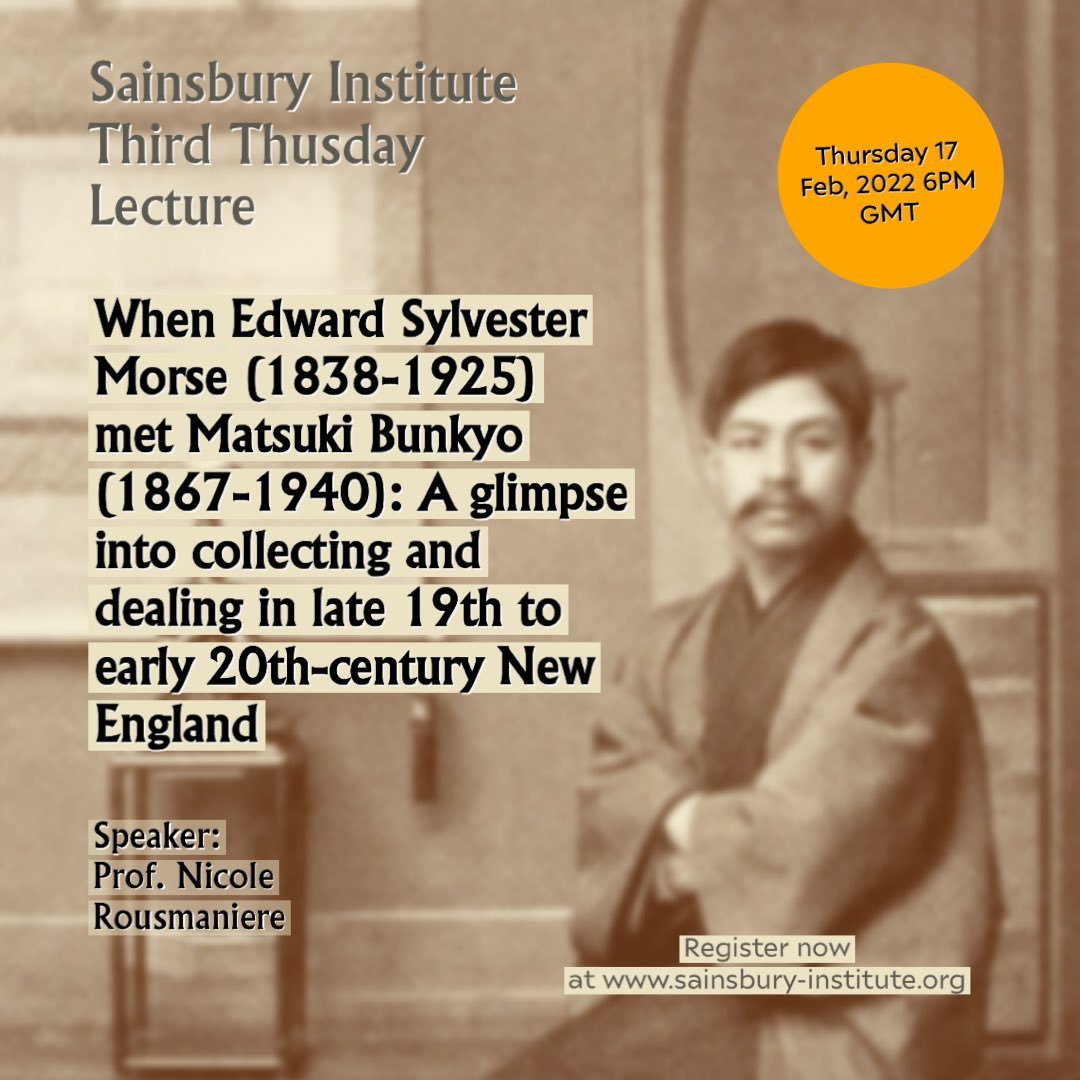Third Thursday Lecture: When Edward Sylvester Morse (1838-1925) met Matsuki Bunkyo (1867-1940): A glimpse into collecting and dealing in late 19th to early 20th-century New England (2022年2月17日)
The talk was briefly opened by Professor Simon Kaner and Professor Nicole Rousmaniere was briefly introduced by Dr. Matsuba Ryoko of SISJAC.
Professor Nicole Rousmaniere explained that her current project was to deal with x and explained she came to Massachusetts, a few miles from Salem, prior to the pandemic for personal reasons, only to be stuck there during the pandemic. Through circumstance, she discovered that the house of Bunkyo (1867-1940) was being sold and she has been attempting to record what information and preserve as much as possible before the house is demolished.
She described both Morse and Bunkyo as ‘men of firsts’ and how they were tied together. She also thanked the staff of SISJAC for their help and support, as well as the late Fed Shaff, a trustee of the MFA.
The Matsuki Bunkyo house is located on Laurel Street in Salem, MA, and she noted Matsuki spelt his given name while in America as ‘Bunkio’ out of personal choice. She also described him as an example of ‘fake it till you make it’ and often lied about his history when talking about himself. He was born in Kamisewa, his family worked in ceramics and at fifteen he enrolled at a school for the priesthood. He then enrolled in an English language class in Tsukiji and was eventually released by the temple at eighteen, he then vanished, possibly going to China, for two years before going to America.
She then moved onto Morse (1838-1925) who she explained had an archive which was preserved by his secretary, hence why so much survived. Prof. Rousmaniere also noted Morse had an interest in shells and zoology. He also became an illustrator for a number of years and a curator of molluscs of what is now known as the Peabody Essex Museum in Rowley, MA.
However finances were an issue with both men but Morse eventually travelled to Japan, where he was offered the position at x. He also discovered the Shell Mounds at Omori near Tokyo, where a statue commemorates his discovery in 1877. He also started the Tokyo University Press, doing his own lithographs and teaching the art to students and, in 1878, Morse moved into kaga yashiki (the domain of a daimyō) in Hongo, Tokyo.
Morse had a particular interest in Japanese pottery and Matsuki first met Morse in x, in Salem. Morse had a house on Linden St, now transformed into four flats, and had an extension built specifically for his extensive ceramics collection. Bunkyo boarded at the Meacom house on Bridge St. while attending the local high school, eventually marrying Martha, the family’s daughter, in 1894.
Matsuki eventually opened a store supplying Japanese goods, including mail order, and played on his nationality as a ‘marker of authenticity’. He also built a Japanese style house in 1895 and the house was created from a book—x — written by Morse in x, who also oversaw the construction. R described it as an American ideal of a Japanese home. Morse also built a house next door, after selling two plots to Matsuki. The house was eventually sold by Martha Meacom Matsuki and features and interesting interior which isn’t actually authentically Japanese, instead more of the idea of a Japanese home, with a few American concessions like a fireplace.
However, things went wrong fast. After marrying in May, October brought news reports that he had beaten his wife. He actually moved and eventually took Martha, who was given the Japanese name of Masako by her husband, to Japan for a honeymoon. However this was more about securing items for purchase at his ever-growing collection of stores. Eventually he sold art supplies, items at auction, ephemera and Buddhist art.
Prof. Rousmaniere concluded her talk with tragedy, with the death in October 1916 of Matsuki’s wife, Martha, who hung herself while he was in Japan on business trips and was found by her children. Prof. Rousmaniere concluded her talk by following Matsuki’s attempt to make a living in New York before moving back to Japan in x. She then moved back to Morse, who died in 1925 and was buried in Harmony Grove Cemetery in Salem next to his wife.
Afterwards, there was a short Q and A session from the audience and the full talk itself can be viewed below:

